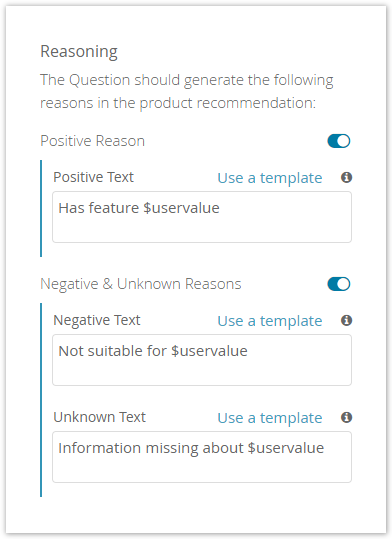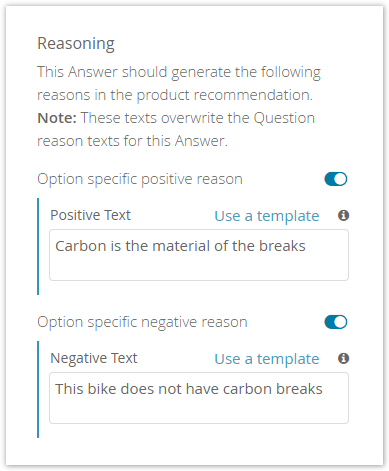The Reasoning settings define what kind of feedback your user receives in the result list of your recommendation phase. This page gives you an overview of all the available settings, shows your the difference between positive and negative reasoning texts and provides with you with a list of convenient reason variables for the ability to customize your result lists even more.
Table of Contents:
Workbench Settings
Question Detail View
The image below shows you the Detail View for a question within the Concept Board:
With the aid of the reasoning section you are able to configure individual reason texts for each Question. The reason texts are shown in the recommendation.
Answer Option Detail View
The image below shows you the Detail View for a answer option within the Concept Board:
For more complex topics, a specific reason text may be helpful. E.g. Using for example plural nouns, lists of several values or very content specific explanations is not possible or only with flaws in the grammar. For this purpose there are Reason Texts for answer options. This is only possible if "The user can select one answer" is set in the Question Settings.
- An Option reason text overrides the text from the Question.
- Unknown reasons are not Answer Option specific.
- The texts are only accessible and editable if the corresponding positive/negative reason toggle button is activated in the Question detail view.
- If the Question allows multi selectable answers, a specific Answer Option reason text cannot be used anymore. In this case the Question reason text is always used
Reason Texts
For the Question you can activate the positive text and you can activate the negative / unknown text separately.
Variable Texts | Description |
|---|---|
Positive Text | The positive text is used to signal that a product has a certain feature or property. |
Negative Text | The negative text is used to signal that a product has not a certain feature or property. |
Unknown Text | The difference between the negative text and unknown text is that this text signals that the product does not contain any information about feature or property. |
Use Case
(see Reasoning Usecase below).
Reason Templates
The reason templates can help to find a good fitting reasoning text. By click on "Use a template" you can select the best fitting reason texts out of a list of template examples.
These examples illustrate how the reason variables can be used. By confirm the selected template text it replaces the text in the reason text input field.
Reason Variables
Reason Variables can be used to enrich your reason texts with dynamic values, depending on the product data and/or the user input. Reason Variables can be simply added into your texts using the notation shown in the list below. Check the lists of applicable variables to understand the different use cases for each reason variable.
Variable List
Variable | Description | Bedingungen | User Selection | Product Value | Example Template | Example |
|---|---|---|---|---|---|---|
$matching | Displays all user-selected Answer Options of the associated Question for which the given product fulfills the requirements defined by the data bindings. | Non | HDMI, DVI, VGA | HDMI, VGA | supports §matching | supports HDMI, VGA |
$nonmatching | Displays all user-selected Answer Options of the associated Question for which the given product does not fulfills the requirements defined by the data bindings. | Non | HDMI, DVI, VGA | HDMI, VGA | no support for §nonmatching | no support for DVI |
$remaining | Displays all Answer Options not selected by the user of the associated Question for which the given product does not fulfill the requirements defined by the data bindings. | Useful, if multiple value are possible on product | HDMI, DVI | HDMI, DVI, VGA | supports §matching (also provides: §remaining) | supports HDMI, DVI (also provides: VGA) |
$unit | Displays the unit or currency of a numeric value configured for the associated Question. You can set this unit Stepping Configuration - Unit. | For questions with numerical options | 100 | 99 | $value $unit | 99 € |
$userRangeMin / $userRangeMax | Define a range, which the user selected. | For questions with numerical options with range selection Please set the Answer Option Type: Continuous numeric Activate: Range selectable | 250 / 600 | 500 | The SSD storage capacity of the laptop is in the defined range of $userRangeMin to $userRangeMax giga byte | The SSD storage capacity of the laptop is in the defined range of 250 to 600 giga byte |
$uservalue | Displays all user-selected Answer Options of the associated Question. | Non | HDMI, DVI | HDMI, DVI, VGA | $uservalue | HDMI, DVI |
$value | Displays all Answer Options that are fulfilled by the product. | Non | HDMI, DVI, VGA | HDMI, VGA | supports $matching | supports HDMI, VGA |
$valueRelevantFirst | Displays all Answer Options that are fulfilled by the product. Answer Options requested by user will be shown first in the list. | Non | HDMI, DVI, VGA | HDMI, VGA | supports $valueRelevantFirst | supports HDMI, VGA, DVI |
Use Case
(see Reasoning Usecase below)
Applicable use cases for Reason Variables
Question Use case
These use cases for the settings for the Question help you to understand the presented settings.
Answer Option Use case
These use cases for the settings for the Answer Option help you to understand the presented settings.
Reason Texts
Positive Text | For example let's assume that the customer wants to have a bike with carbon breaks and some of the recommended bikes have these breaks. Then the product recommendation card contains a positive feedback about this feature. As a default the text "Supported: carbon breaks" is displayed. This text is OK but of course very generic. That is why you are able to individualize this text to match the topic or environment of the displayed information. So the text could be: "The bike has carbon breaks". |
Negative Text | So let's adapt the example above and assume that a bike does not have the wished carbon breaks. In this case you can enter the text "Unfortunately this bike does not have $uservalue" which results into the product reason text "Unfortunately this bike does not have carbon breaks". |
Unknown Text | So a possible text could be "There are no information about the break type". |
Reason Variables
For example now we have a specific text for this topic but we also have the problem that this text does not match with aluminum or steel breaks. With the aid of these variables you can match different answers. So if you enter the text "The bike has $uservalue" the contained variable will be replaced by the text of the Answer Option label which the user has selected.Possible results:- User selects carbon breaks → "The bike has carbon breaks"
- User selects steels breaks → "The bike has steel breaks"
- User selects aluminum breaks → "The bike has aluminum breaks"
- etc. ...
Reason Variables
Possible specific texts:- Carbon is the material of the breaks
- One battery is contained
- Two batteries are contained


